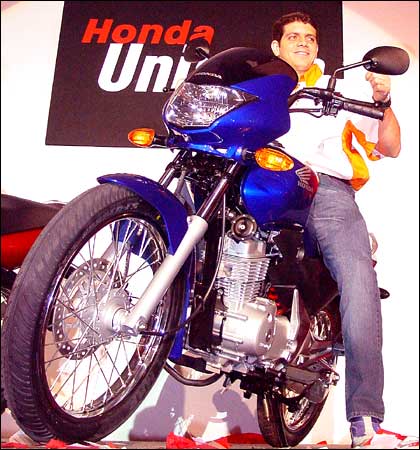 Honda has finally unveiled the bike that threatens to flip the whole premium segment on its ear. Called the Unicorn, Honda's choice of name leaves nothing to the imagination.
Honda has finally unveiled the bike that threatens to flip the whole premium segment on its ear. Called the Unicorn, Honda's choice of name leaves nothing to the imagination.
The high point of the motorcycle, and in fact, the only real step forward for Indian motorcycling on the whole, is the monoshock suspension system that returns after a long break.
Yes, the first monoshock motorcycle in India was the Spitfire (made by Brooke Bond, this 50cc, on/off road bike had a 5.5 bhp Moto Morini engine and cost Rs 10,000 in 1986).
However, there is more to the Unicorn than just rear suspension. Honda says the motorcycle, like the Eterno, was designed to meet the needs of Indian customers, and in that sense, it is unique within Honda's huge global range of motorcycles.
Honda's research showed that people buying motorcycles in the premium segment looked at acceleration, fuel economy (not less than 55 kpl), styling, ride comfort and stability, reliability and price as factors in the purchase decision, in that order of importance.
As a result, Honda's tuned their 13.3 bhp, 149.1cc engine to produce a class-leading 1.3 kgm of torque at a class-lowest 5500 rpm. As a direct consequence, Honda have chosen slightly taller ratios for the gearbox and still claim a 5-second run to 60 kph, which is quicker than the competition.
The Unicorn's engine uses a high torque output, 5-speed gearbox, a CV carburettor and a digital ignition system with multiple maps (similar to Yamaha's Fazer) to balance high acceleration with steady fuel economy Honda claims 60 kpl in daily use.
Honda openly admits that the bike's styling isn't the freshest in the segment, but reiterates that the look is based squarely on consumer feedback. So the front fairing is vaguely reminiscent of the Kawasaki Bajaj Wind 125 and the rest has strong CBZ overtones.
As a package however, while the Unicorn is easy on the eye, it isn't distinguished by any particular element, apart from the impression of solid build quality and superb finish levels. The three-pod instruments and double tail lamp a la Karizma are nice touches.
To tackle ride quality and stability requirements, Honda chose a combination of a long wheelbase (1,340 mm) and monoshock rear suspension.
In conjunction with a single-downtube frame employing the engine as a stressed member, the Unicorn promises to be supremely stable and possess a very high quality of ride. Honda also assures super ergonomics, to round out what should be a very comfortable motorcycle.
Among the other details, Honda chose to include a primary kick starter (and omit an electric start altogether) and unlike the Bajaj Pulsar 150 DTSi and TVS Fiero F2/FX, offer a regular one-down, four-up gearshift pattern. Also, like the Activa, the Unicorn will have 'Tuff-up' tubes that slow down pressure loss if they get punctured.
Honda has priced the Unicorn very close to the similarly spec-ed Pulsar 150 DTSi, the difference working out to a few hundred rupees.
Honda has announced that their sole kick start and disc brake Unicorn will be Rs 50,043, 50,059, 47,811, 50,323 and 51,124, ex-showroom in Delhi, Mumbai, Pune, Bangalore and Chennai respectively. However, the omission of the electric starter could be an oversight. Bajaj currently sells twice as many starter-equipped 150s than it does kick-starts.
Alex Barros, world No.8 Formula 1 motorcycle driver, poses with Honda Unicorn during its launch in New Delhi on September 8. Photo: Dijeshwar.Singh/Saab Press





